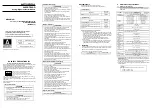
Page 20 H0 Sound Decoder MX640
Shunting and half-speed functions:
By defining the different Configuration Variables (#3, 4, 121, 122, 123), a prototypical acceleration
and deceleration behavior is achieved that often makes shunting very difficult.
With the help of CV #124, a shunting key can be defined (either the dedicated MAN key within a
ZIMO system or the keys F4 or F3) with which the acceleration and deceleration rates may be re-
duced or eliminated all together.
CV #124 may also be used to define either F7 or F3 as low gear key. With this function turned on,
the throttle is used for half the decoder’s full speed range, which is just like shifting down into low
gear.
Example: The F7 key should act as low gear and the F4 key should reduce the momentum down to
¼. According to the CV table, the bits in CV #124 are to be set as follows: Bit 0 = 0, Bit 1 = 1, Bit 2
= 1 and Bit 3 = 1. The sum of the individual bit values (0+2+4+8 = 14) is entered as a decimal
value.
“On-the-fly” - programming (a.k.a. on-the-main):
Configuration variables can also be changed on the main track as well as on the programming
track, without interfering with other trains operating on the layout.
All CV’s, with the exception of address CV’s, can be modified on the main. Please note though that
the verification and read-out of CV values will not be possible until the bidirectional communication
is implemented (in the course of 2006 with SW updates for the ZIMO command stations “model
2000” and MX1EC as well as decoders).
If no bidirectional communication is available, “on-the-fly” programming should primarily be used for
CV’s where a change is immediately visible (e.g. Vstart, Vmax, signal controlled speed influence
settings, etc). Don’t use it to program the 28 speed steps in the speed table for example, which is
preferably done at the programming track (where programming can be confirmed through acknowl-
edgments).
Consult the ZIMO cab instruction manual for on-the-fly programming steps!
















































